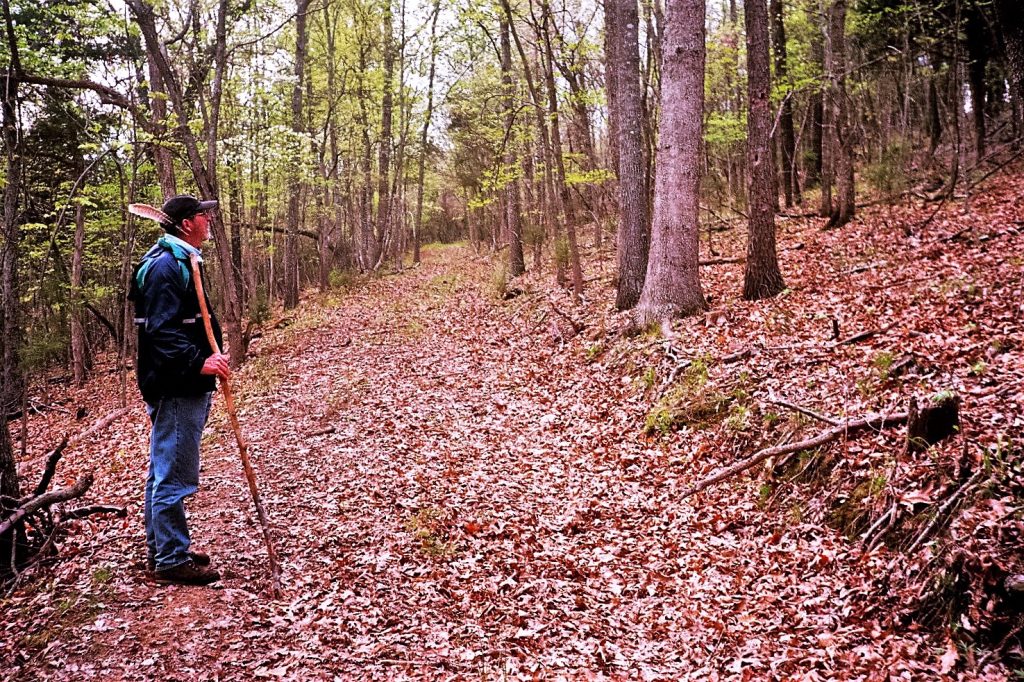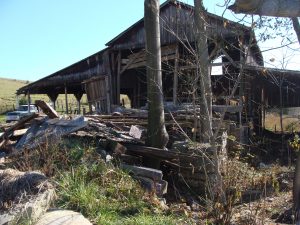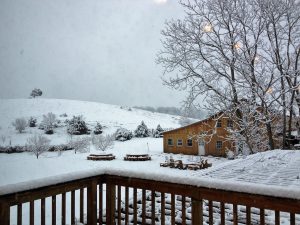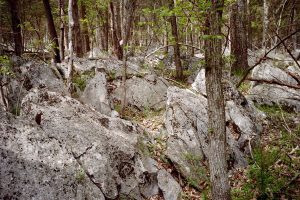A Brief History of HEARTSTONE COUNTRY RETREAT

At 250 acres, Heartstone Country Retreat is the largest remaining contiguous parcel of the original 600 acre plus Skaggs Springs Farm, one of the earliest tracts of settled land in Rockbridge County. From virgin timber in the 1700’s the land was cut over and opened by the Civil War Era. Wood was both the fuel for farm and home and the fuel for iron smelting, railroading, and sugaring. It was cut for tanning bark, burned to clear land for wheat, and used to build homes and barns.
 Those original chestnut barns are all gone now, but the stone foundations for a very large bank barn still remain surrounding the Stone Garden at Heartstone. The stones, weighing in at several hundred pounds each were quarried here and set in place either with a passel of sons and neighbors, or more likely, with the help of slaves and mules. Moving them for us required a good sized tractor and was still a difficult task. Disassembling the remnants of that barn revealed the strength of mortise and tenon construction and hammered pegs. The framework was still sturdy over a hundred and fifty years later though the design was no longer useful and siding, floor, and roof were rotted away.
Those original chestnut barns are all gone now, but the stone foundations for a very large bank barn still remain surrounding the Stone Garden at Heartstone. The stones, weighing in at several hundred pounds each were quarried here and set in place either with a passel of sons and neighbors, or more likely, with the help of slaves and mules. Moving them for us required a good sized tractor and was still a difficult task. Disassembling the remnants of that barn revealed the strength of mortise and tenon construction and hammered pegs. The framework was still sturdy over a hundred and fifty years later though the design was no longer useful and siding, floor, and roof were rotted away.
 With the timber gone wheat dominated the gentler slopes while regrowth began in the hollows and steeper portions of the classic hill farm. The inevitable loss of top soil stopped with the rise of competition in the opening of the West to large scale wheat and the switch to grass and timber that dominates the agricultural scene today. Nobody ever got rich on a hill farm, but many long and happy lives were passed in the care of this land. There was ample water, the famous Skaggs Springs that run even today with a stream of water as big as a brawny man’s arm. That water and rich grass was captured by a ram pump and fed to a reservoir on the top of our Heartstone hill to supply dairy and horse pasture. Local residents now nearing retirement can remember working on the dairy, setting out five gallon cans of milk and cream for pick up on the single lane road that followed the old canal line cutting across the farm before heading to the train station and market.
With the timber gone wheat dominated the gentler slopes while regrowth began in the hollows and steeper portions of the classic hill farm. The inevitable loss of top soil stopped with the rise of competition in the opening of the West to large scale wheat and the switch to grass and timber that dominates the agricultural scene today. Nobody ever got rich on a hill farm, but many long and happy lives were passed in the care of this land. There was ample water, the famous Skaggs Springs that run even today with a stream of water as big as a brawny man’s arm. That water and rich grass was captured by a ram pump and fed to a reservoir on the top of our Heartstone hill to supply dairy and horse pasture. Local residents now nearing retirement can remember working on the dairy, setting out five gallon cans of milk and cream for pick up on the single lane road that followed the old canal line cutting across the farm before heading to the train station and market.
 Limestone karst, the underpinnings of the soil here in the Valley is a famous water breeder, supplying the source for the crystal clear water that still feeds all the cabins and the lodge. The same karst formation eroded by slow moving underground streams has created numerous sink holes including two or three active areas as the overburden collapsed into caves dissolved away under the ground. On the edge facing the Blue Ridge, the exposed limestone layers looking like teeth grinning permanently at the river below have been named Los Dientes by ourselves and edge a wonderful circular trail that circumnavigates cedar, oak, poplar, replanted pine, and edge fields before popping out on the top of our highest hill and an “as far as the eyes can see” view. The rise from Maury River edge to hilltop is in the vicinity of five hundred feet. Well above high water for any of the cabins and looking from Blue Ridge to Alleghenies and the “left behinds” that dot the valley here at the mouth of the Shenandoah.
Limestone karst, the underpinnings of the soil here in the Valley is a famous water breeder, supplying the source for the crystal clear water that still feeds all the cabins and the lodge. The same karst formation eroded by slow moving underground streams has created numerous sink holes including two or three active areas as the overburden collapsed into caves dissolved away under the ground. On the edge facing the Blue Ridge, the exposed limestone layers looking like teeth grinning permanently at the river below have been named Los Dientes by ourselves and edge a wonderful circular trail that circumnavigates cedar, oak, poplar, replanted pine, and edge fields before popping out on the top of our highest hill and an “as far as the eyes can see” view. The rise from Maury River edge to hilltop is in the vicinity of five hundred feet. Well above high water for any of the cabins and looking from Blue Ridge to Alleghenies and the “left behinds” that dot the valley here at the mouth of the Shenandoah.
 Before the coming of the railroad after 1870, the Chesapeake and Kanawah Canal connected Lexington to the world. The timber stage lock is still intact riverside despite huge floods that have swept away the original dams, the rail beds, and many of the small homes that were built up on the flats beside the river. Robert E. Lee arriving here after the war came by stage personally, but his household goods would certainly have come up river from the tidewater on the canal. Travel by coach was rough and dirty, slow and dangerous. Travel by canal boat was described as a dream voyage by honeymooners loafing on top the canal boat in the moonlight as it drifted slowly down water on its way to Richmond and the passage to abroad. It was possible then to travel to England and never set foot on land once boarding the canal here in Rockbridge!
Before the coming of the railroad after 1870, the Chesapeake and Kanawah Canal connected Lexington to the world. The timber stage lock is still intact riverside despite huge floods that have swept away the original dams, the rail beds, and many of the small homes that were built up on the flats beside the river. Robert E. Lee arriving here after the war came by stage personally, but his household goods would certainly have come up river from the tidewater on the canal. Travel by coach was rough and dirty, slow and dangerous. Travel by canal boat was described as a dream voyage by honeymooners loafing on top the canal boat in the moonlight as it drifted slowly down water on its way to Richmond and the passage to abroad. It was possible then to travel to England and never set foot on land once boarding the canal here in Rockbridge!
Lost in the archaeology of all old things are the bones of the brick yard, the timber landing, the rail lines, and the community of freed slaves that once lined the river world here. Hurricanes and floods have erased most, and fire and the rising wealth of the area have destroyed the rest. Fortunately, the bricks making up the chimney of our oldest cabin, the Highlands, are salvaged from the big house that once stood riverside at the road entrance to the cabin. The canal lock could still work today with rebuilt dam and gates.
The current mix of cove timber, secondary regrowth, edge territory of shrub and vine and open field supports every species known to inhabit southwest Virginia valley and mountain. The only exception is the red wolf recently reintroduced into the Smokies, the bison long gone from our meadows and perhaps the mountain lion. Sightings of large tracks and a large, golden lion like animal some miles downriver from us remain unverified by wildlife experts. The locals, however, are sure that the “painter” is returning to its original range.
Certainly deer are back in profusion, turkey, coyote or “brush wolf”, minor predators and even the black bear.In fifteen years there have been bear sightings that are probably one of the year’s crop of newbies searching for a home as they repopulate from the National Forest eight miles away to other land. We could not easily support an indigenous bear population, but are always excited to see or hear of the passer through.
Coyote are more suited for re-population. Living in family groups from the time pups are born until late February when they begin to disperse, their song may be heard from night to night in season. The young ones playing on earth mounds or loping along a rabbit trail are a joyous sight, playful, wise, unafraid, and definitely capable. They are ideally suited to live near human beings in the new ecology of man and nature complimenting one another.
For those attuned to ley lines and the layering of the earth mantle the farm is a wonder spot. Created by the irresistible nudge of Africa pushing into the Blue Ridge in the time of Pangaea, we are on the edge of the earth fold that is our mountains across the South River. The river is the low point of that joint. When Africa retreated creating the Atlantic Ocean we were left behind. We like to think we can stand on our highest hill and look across the Blues to our old homeland Africa. To the west are the Alleghenies, younger, rougher, pushed away much more rapidly leaving behind places where the roots ran deep and the tops were sheathed in granite.
Then came the ocean covering the valley in a gigantic inland sea. Over millions of years hundreds of feet of limestone were laid down, exceeding a mile in places. Every grain of the limestone was once a living creature teeming in warm sea, dying and layering the bottom in bone.
Nothing is forever in geological time. The Ice Age and glaciers pushing down the land grinding away hundreds of feet of limestone exposing the granite tops of the deep rooted ones like House Mountain, Jump Mountain, and Hog Back Mountain. When they receded in turn only a few tens of thousands ago, the valley was exposed in more or less its current configuration. Wherever we stand on this land, there is history under our feet. Iron ore from volcanism. Fossils from the ancient seas. Red clay that makes the famous Lexington bricks. Bones emerging as erosion continues to slough off layers of hard built top soil showing more bones beneath. Take a long, slooooooow breath and feel the movement of the earth and know. This is a special place. Perfect in all its bumps and hollows. It has endured. It has evolved. It will continue. We are simply visitors here, passing through for a short while. The earth endures.
As you walk the hills, woods, peaks and valleys, experience this long, slow breathing pulse of earth. And relax. It is all good. All okay. All just as it should be. At Peace…
